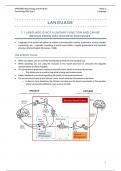Summary
Summary Language Notes for BSc Psychology: Psychology and the Brain
- Institution
- Kings College London (KCL)
Complete revision and summary notes for Language for BSc Psychology: Psychology and the Brain Module. Written by a straight A* King's College London student set for a 1st. Well organised and in order. Includes diagrams and full reference section and collated information from lectures, seminars...
[Show more]



